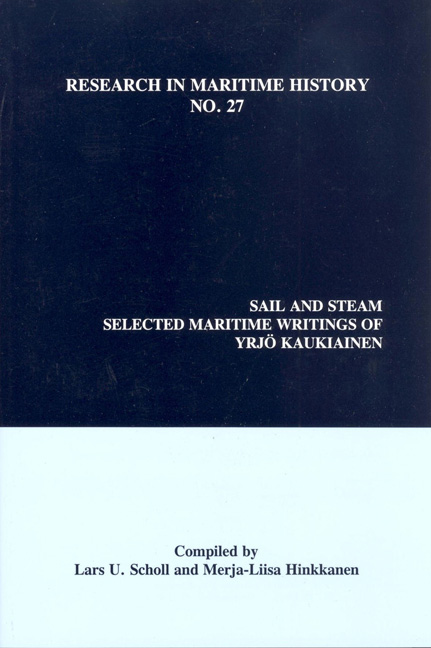Book contents
- Frontmatter
- Frontispiece
- Table of Contents
- Acknowledgements
- “Yrjö Kaukiainen: A Tribute on the Occasion of his Forthcoming Retirement as Professor of Maritime History at the University of Helsinki”
- “Yrjö Kaukiainen: A Man of the Sea”
- “Yrjö Kaukiainen and the Development of Maritime Economic History”
- “Finnish Sailors, 1750-1870”
- “Finnish and International Maritime Labour in the Age of Sail: Was There a Market?”
- “Five Years before the Mast: Observations on the Conditions of Maritime Labour in Finland and Elsewhere”
- “The Maritime Labour Market: Skill and Experience as Factors of Demand and Supply”
- “Owners and Masters: Management and Managerial Skills in the Finnish Ocean-Going Merchant Fleet, c. 1840-1880”
- “From Low-Cost to High-Cost Shipping: Finnish Maritime Labour Costs after the Second World War”
- “The Modernization of Finnish Coastal Shipping and Railway Competition c. 1830-1913”
- “British Timber Imports and Finnish Shipping 1860-1910”
- “Baltic Timber-Trade under Sail: An Example of the Persistence of Old Techniques”
- “Coal and Canvas: Aspects of the Competition between Steam and Sail, c. 1870-1914”
- “Dutch Shipping and the Swedish Navigation Act (1724). A Case Study”
- “Seamen Ashore: Port Visits of Late Nineteenth-Century Finnish Sailors”
- “Wreck-plundering by East Finnish Coastal People - Criminal Tradition or Popular Culture?”
- “From Days and Knots to Pounds and Dollars: Some Problems in the Study of the Economics of Late Nineteenth Century Merchant Shipping”
- “Tons and Tonnages: Ship Measurement and Shipping Statistics, c. 1870-1980”
- “International Freight Markets in the 1830s and 1840s: The Experience of a Major Finnish Shipowner”
- “Shrinking the World: Improvements in the Speed of Information Transmission, c. 1820-1870”
- “Yrjö Kaukiainen: A Maritime Bibliography”
“Seamen Ashore: Port Visits of Late Nineteenth-Century Finnish Sailors”
- Frontmatter
- Frontispiece
- Table of Contents
- Acknowledgements
- “Yrjö Kaukiainen: A Tribute on the Occasion of his Forthcoming Retirement as Professor of Maritime History at the University of Helsinki”
- “Yrjö Kaukiainen: A Man of the Sea”
- “Yrjö Kaukiainen and the Development of Maritime Economic History”
- “Finnish Sailors, 1750-1870”
- “Finnish and International Maritime Labour in the Age of Sail: Was There a Market?”
- “Five Years before the Mast: Observations on the Conditions of Maritime Labour in Finland and Elsewhere”
- “The Maritime Labour Market: Skill and Experience as Factors of Demand and Supply”
- “Owners and Masters: Management and Managerial Skills in the Finnish Ocean-Going Merchant Fleet, c. 1840-1880”
- “From Low-Cost to High-Cost Shipping: Finnish Maritime Labour Costs after the Second World War”
- “The Modernization of Finnish Coastal Shipping and Railway Competition c. 1830-1913”
- “British Timber Imports and Finnish Shipping 1860-1910”
- “Baltic Timber-Trade under Sail: An Example of the Persistence of Old Techniques”
- “Coal and Canvas: Aspects of the Competition between Steam and Sail, c. 1870-1914”
- “Dutch Shipping and the Swedish Navigation Act (1724). A Case Study”
- “Seamen Ashore: Port Visits of Late Nineteenth-Century Finnish Sailors”
- “Wreck-plundering by East Finnish Coastal People - Criminal Tradition or Popular Culture?”
- “From Days and Knots to Pounds and Dollars: Some Problems in the Study of the Economics of Late Nineteenth Century Merchant Shipping”
- “Tons and Tonnages: Ship Measurement and Shipping Statistics, c. 1870-1980”
- “International Freight Markets in the 1830s and 1840s: The Experience of a Major Finnish Shipowner”
- “Shrinking the World: Improvements in the Speed of Information Transmission, c. 1820-1870”
- “Yrjö Kaukiainen: A Maritime Bibliography”
Summary
In Jack in Port, Judith Fingard painted a vivid description of what she called “the demise of sailortown.” Life in port cities, she claimed, underwent a profound change during the nineteenth century. The seamen of the 1820s, 1830s and 1840s still enjoyed “the unhurried pace of the pre-industrial age” which “meant that sailors’ visits to port were sufficiently lengthy to enable them to make a significant contribution to both the economy and the character of sailortown.” Yet the following generation, sailing in the 1850s, 1860s and 1870s (when “the opportunities for seafaring grew by leaps and bounds”) experienced an increase in the tempo of shipping which, among other things, shortened stays in ports. But the greatest changes came at the end of the century: “The third generation sailor, active in the last quarter of the century, belonged to a dying occupation… [when] the short stopovers characteristic of the new pace of commerce allowed the sailor little time to go ashore…As a result the late 1890s saw the demise of sailortown.”
While this description is doubtless true for the principal seaports of Atlantic Canada, it is important to remember that international ports have continued to change rapidly even after “the demise of sailortown.” Indeed, present-day ports have little in common with even the most developed harbours of a century ago. Moreover, the scale and scope of the change have been different in various parts of the world as well as disparate types of ports. It is clear, however, that Fingard has underscored a fundamental change which has been equally important during this century: the shortening of time in port. While midnineteenth century sailing vessels spent weeks or even months in port, typical turnaround times for modern ships are now counted in hours. Accordingly, the presence of sailors has diminished even in traditional “steamer ports.”
While the general picture is clear enough, it is not easy to fmd relevant data on the actual speed and magnitude of the change. While there are some good local data on turnaround times, such as those published by the Atlantic Canada Shipping Project, systematic statistics covering longer spans of time are the exception. Moreover, quantitative data on time in ports are far from sufficient to understand how the profound transformation of shipping has affected ports and port cities.
- Type
- Chapter
- Information
- Sail and SteamSelected Maritime Writings of Yrjö Kaukiainen, pp. 141 - 150Publisher: Liverpool University PressPrint publication year: 2004

